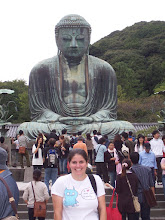This will be my last post about Tokyo. Next we move on to Kyoto.
Even with the lights up the theater is dim. We are on the fourth floor, in a tiny balcony with only two rows of red upholstered seats. Far below, a man in traditional Japanese garb stands before a background of cherry blossoms. I can't understand him, so my mind wanders. Paper bags and programs rustle. My earphone guide pipes plinking rainwater music int o my left ear.
Finally the man raises his arms and says what sounds like hiiooo. The crowd responds by clapping in rhythm 3-3-3-2. The man leaves this stage, causing an eruption of activity in the audience. Men in suits leave their seats. People talk and fidget. Bells ring as men and women pull out their cell phones to check one last message.
The curtain is pulled across by an unseen stage hand, blocking the cherry blossoms from sight and replacing them with a series of red, green and black stripes.
The drums begin and so does the commentary. It informs me that in this performance "the ritual [of the seven greens] and a tale of revenge are combined to create a graceful prayer for good fortune." While I am still puzzling through the psychology of this statement, the audience claps. The curtain has risen revealing a stage. Twenty men sit on red covered risers. Some have song books, others instruments. All are in traditional dress.
The three characters of the dance appear out of a rectangular hole in the stage. As they come into view members of the audience yell out the stage names of the actors.
The 'woman' wears a red kimono embroidered in gold and bits of green. The lining is white, her sash, yellow. Her headdress is an amazing sculpture of diamonds - it's hard to believe that this beautiful girl is really a man.
The other two actors, the Soga brothers, wear pale blue over garments with white designs on them. The legs are so long that they trail a yard past the actors' feet. Their undershirts are red with two white stripes running from sleeve to sleeve across the chest. Each carries a small drum.
The hands, necks and faces of all three are painted white. So they look like china dolls who have learned to dance.
Now they prepare for the ritual of the seven greens. The greens are eaten on the 7th day of the New Year, a ritual that is still performed to this day. Coincidentally, today is the seventh.
In this performance, the Soga brothers - figures of Japanese folk lore - prepare to seek revenge on the man who had their father killed. They do this by performing the ritual of the seven greens. During the ritual seven types of greens are picked, prepared and eaten.
The commentary informs me that "the Soga brothers' wish for success of their vendetta, and by extension, this becomes a wish for good fortune for all who watch this dance."
By now I am too engrossed in the stage to worry about the psychology.
The dancers move with perfect precision. The stamping of their wooden sandals stays in perfect time with the music. Now and then a fan calls out an actor's name, but I hardly notice. For a few moments there is only music and dance and the swirling colors of the actors clothes.
There is nothing in the Western world that even begins to compare to this. Forget ballet. Forget opera. This is Kabuki.
All too soon, it is over. The lights come up. We go on to our next adventure.
Today I leave you with a quote from Mata Hari, "The dance is a poem of which each movement is a word."



